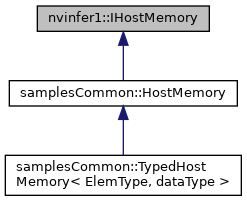Class to handle library allocated memory that is accessible to the user. More...

Public Member Functions | |
| virtual void * | data () const noexcept=0 |
| A pointer to the raw data that is owned by the library. More... | |
| virtual std::size_t | size () const noexcept=0 |
| The size in bytes of the data that was allocated. More... | |
| virtual DataType | type () const noexcept=0 |
| The type of the memory that was allocated. More... | |
| virtual void | destroy () noexcept=0 |
| Destroy the allocated memory. More... | |
Protected Member Functions | |
| virtual | ~IHostMemory () |
Class to handle library allocated memory that is accessible to the user.
The memory allocated via the host memory object is owned by the library and will be de-allocated when the destroy method is called.
|
inlineprotectedvirtual |
|
pure virtualnoexcept |
A pointer to the raw data that is owned by the library.
Implemented in samplesCommon::HostMemory.

|
pure virtualnoexcept |
The size in bytes of the data that was allocated.
Implemented in samplesCommon::HostMemory.

|
pure virtualnoexcept |
The type of the memory that was allocated.
Implemented in samplesCommon::HostMemory.
|
pure virtualnoexcept |
Destroy the allocated memory.
Implemented in samplesCommon::TypedHostMemory< ElemType, dataType >.
